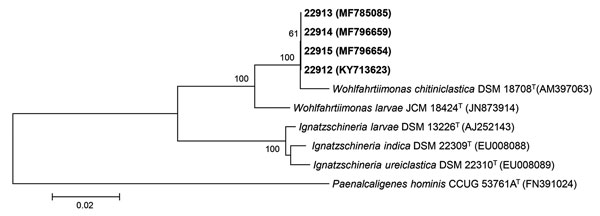Volume 24, Number 2—February 2018
Dispatch
Fly Reservoir Associated with Wohlfahrtiimonas Bacteremia in a Human
Figure 2

Figure 2. Neighbor-joining phylogenetic tree of 16S rRNA gene sequences of Wohlfahrtiimonas spp. isolate from a patient with septicemia and wound myiasis in Washington, USA (laboratory identification no. 22912), isolates from flies and fly larvae (laboratory identification nos. 22913, 22914, 22915), and the most closely related type strains. Numbers at nodes denote bootstrap percentages based on 1,000 replicates; only values >50% are shown. GenBank accession numbers are given in parentheses. Bold indicates strains isolated in this study. The tree was rooted with Paenalcaligenes hominis CCUG 53761AT as the outgroup. Scale bar indicates substitutions per nucleotide position.
Page created: January 17, 2018
Page updated: January 17, 2018
Page reviewed: January 17, 2018
The conclusions, findings, and opinions expressed by authors contributing to this journal do not necessarily reflect the official position of the U.S. Department of Health and Human Services, the Public Health Service, the Centers for Disease Control and Prevention, or the authors' affiliated institutions. Use of trade names is for identification only and does not imply endorsement by any of the groups named above.